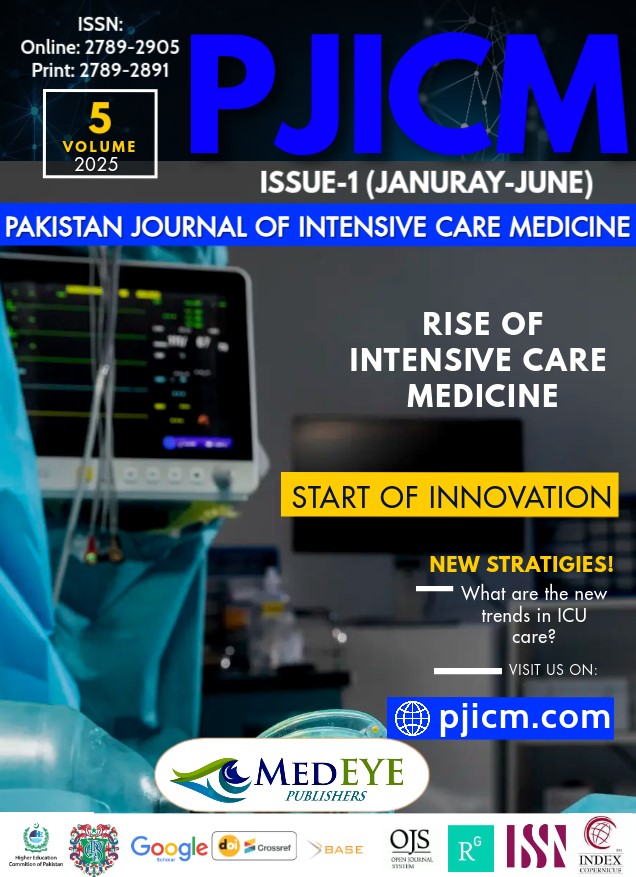ROLE OF BUBBLE CONTINUOUS POSITIVE AIRWAY PRESSURE (CPAP) IN RESPIRATORY DISTRESS IN PRETERM NEONATES
DOI:
https://doi.org/10.54112/pjicm.v5i01.42Keywords:
Respiratory Distress Syndrome, Neonates, bCPAPAbstract
Background: Respiratory distress syndrome (RDS) is a leading cause of neonatal morbidity and mortality, particularly in preterm infants. Non-invasive ventilation strategies, such as bubble continuous positive airway pressure (bCPAP), have been shown to reduce the need for mechanical ventilation and improve pulmonary outcomes by preventing alveolar collapse and enhancing functional residual capacity. However, the efficacy and success rates of bCPAP in neonates with RDS require further evaluation. Objective: To assess the success rate of bCPAP therapy in neonates with RDS and determine factors influencing treatment outcomes. Study Design: A descriptive case series. Setting: Department of Pediatrics, Sughra Shafi Medical Complex, Narowal. Duration of Study: Six months, from March 7, 2023, to September 7, 2023. Methods: A total of 193 neonates diagnosed with RDS, meeting the inclusion criteria, were enrolled in the study. bCPAP failure was defined as the need for a fraction of inspired oxygen (FiO2) >40%, CPAP pressure >10 cm H₂O, surfactant administration, or mechanical ventilation. Data were collected on demographic and clinical parameters, including gestational age, birth weight, Apgar score, and Downe’s score. Statistical analysis was conducted using SPSS version 25. Data stratification was performed based on gender, age, birth weight, gestational age, Apgar score, and baseline Downe’s score. The Chi-square test was used to determine associations, with a p-value of ≤0.05 considered statistically significant. Results: Among the 193 neonates, 128 (66.3%) were male, and 65 (33.7%) were female. The mean age of neonates was 16.35 ± 6.534 days, with a mean gestational age of 35.41 ± 5.341 weeks. The mean birth weight was 2735.41 ± 18.413 grams. The mean Downe’s score at baseline was 7.48 ± 1.104, and the mean Apgar score was 7.55 ± 2.35. The success rate of CPAP therapy was observed in 176 (91.2%) neonates. Conclusion: bCPAP is a highly effective non-invasive respiratory support modality for neonates with RDS, demonstrating a high success rate. These findings underscore the importance of early CPAP intervention in reducing the need for mechanical ventilation. Further studies are warranted to explore factors influencing CPAP failure and optimize neonatal respiratory care strategies.
References
Lv B, Gao XR, Sun J, Li TT, Liu ZY, Zhu LH, et al. Family-centered care improves clinical outcomes of very-low-birth-weight infants: a quasi-experimental study. Frontiers Pediatr. 2019;7:138.
Condò V, Cipriani S, Colnaghi M, Bellù R, Zanini R, Bulfoni C, et al. Neonatal respiratory distress syndrome: are risk factors the same in preterm and term infants? J Maternal-Fetal Neonat Med. 2017;30(11):1267-72.
Al-shaer OS, Behiry EG, Elsadek AE, Salama SA. Association between interleukin-10 genetic variant (-1082G>A) with detection and severity of respiratory distress syndrome in preterm neonates. Int J Immunoge. 2020;47(1):50-6.
Abou-Faddan HH, Abdelaziz N. Respiratory distress and its outcome among neonates admitted to neonatal intensive care unit of assiut university children hospital, Egypt. Egyptian J Community Med. 2018;36(2):69-78.
Ezenwa P, Akintan P, Fajolu I, Ladele J, Ezeaka C. Bubble CPAP in the management of respiratory distress syndrome in resource constrained settings: the LUTH experience. Pediatric Oncall. 2018;13(1):9-12.
Ajanwaenyi J, Bamidele O, Osim C, Salami O, Umukoro C, Idaboh T, et al. The minimal invasive surfactant therapy: experience from a low resource setting. J Maternal-Fetal Neonat Med. 2021:1-7.
Mangu CD, Rumisha SF, Lyimo EP, Mremi IR, Massawe IS, Bwana VM, et al. Trends, patterns and cause-specific neonatal mortality in Tanzania: a hospital-based retrospective survey. Int Health. 2020;13(4):334-43.
Tagare A, Kadam S, Vaidya U, Pandit A, Patole S. Bubble CPAP versus ventilator CPAP in preterm neonates with early onset respiratory distress—a randomized controlled trial. J Tropical Pediatr. 2013;59(2):113-9.
Martin S, Duke T, Davis P. Efficacy and safety of bubble CPAP in neonatal care in low and middle income countries: a systematic review. Arch Dis Childhood - Fetal Neonat Ed. 2014;99(6):495.
Soomro T, Tikmani SS. Success of Bubble CPAP in Treatment of Respiratory Distress Syndrome in Preterm Infants . J Gen Pract (Los Angel). 2016;4:264-8.
Agarwal S, Maria A, Roy MK, Verma A. A randomized trial comparing efficacy of bubble and ventilator derived nasal CPAP in preterm babies with respiratory distress. J Clinic Diagnostic Res. 2016;10(9):9-12.
Engle WA. Surfactant replacement therapy for respiratory distress in preterm and term neonate. Pediatr. 2008;121;419-32.
Taeusch HW, Ramierez-Schrempp D, Laing IA. Surfactant treatment of respiratory disorders. In: Taeusch HW, Ballard RA, Gleason CA, editors, Avery’s Disease of Newborn. 8th edition. Philadelphia. 2005;670-85.
AARC clinical practice guidelines. Surfactant replacement therapy. Respiratory care. 1994;39:824-9.
Buch P, Makwana AM, Chudasana RK. Usefulness of Downe’s score as clinical assessment tool and bubble CPAP as primary mode of respiratory support in neonatal respiratory distress syndrome. J Pediatr Sci. 2013;5(1):176-80.
Urs SP, Khan F. Bubble CPAP-A primary respiratory support for respiratory distress syndrome in newborns. Indian Pediatr. 2009;46:409-11.
Koti J, Murki S. Bubble CPAP for respiratory distress syndrome in preterm infants. Indian Pediatr. 2010;47:139-43.
Ammari A, Suri M, Milisavljevic V, Sahni R, Bateman D, Sanocka D, et al. Variables associated with the early failure of nasal CPAP in very low birth weight infants. J Pediatr. 2005;147(3):341-47.
Parasuramappa H, Belavadi G. A descriptive study on the use of bubble CPAP in a level 2 neonatal intensive care unit in Bangalore, India. Sri Lanka J Child Health. 2017;46(3):211-7.
Downloads
Published
How to Cite
Issue
Section
License
Copyright (c) 2025 M AFTAB , E ROSHAN , K HAYYAT , M UZAIR , M MATEEN , S JAVED

This work is licensed under a Creative Commons Attribution-NonCommercial 4.0 International License.












